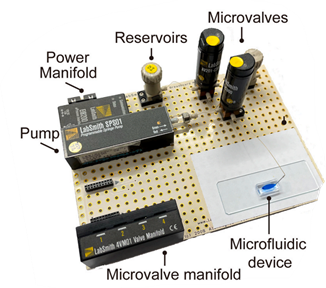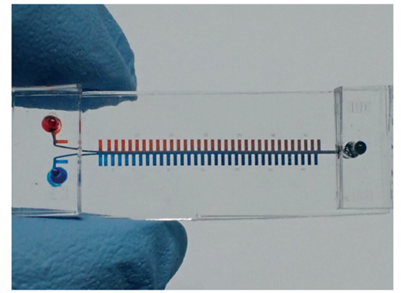研究主題:晶片上的實驗室-光微流道生醫系統
撰寫:學生陳冠彬
微流道技術是在透明的晶片中製作微米尺度的腔室或通道,讓生物樣本在晶片中流動完成操作,包括抽取、分離、混合、分散和移動等。這項技術將原先需要在整個實驗室中不同部門的工作整合到一個晶片上,因此稱為「晶片上的實驗室」。
黃念祖教授在2021年7月發表在Biosensors and Bioelectronics中的文章[1]提到,利用光微流道系統可以進行抗菌敏感性試驗(AST)。AST是治療血液感染病患時使用的技術,通過AST測試可以確定病患感染的細菌種類,進而投放有效的抗生素治療。然而,現有的AST技術需要耗費整晚時間進行檢測。因此,這項研究提出了利用結合光學檢測的微流道系統,在一片晶片上縮短AST檢測時間為3.5小時。
在2022年3月,發表於Lab on a Chip的期刊[2]中,提出了進化的微流道AST檢測技術。新的微流道晶片具有64個獨立的微米孔槽,可以將待測生物樣本分離到各個孔槽並同時測試,從一片晶片只能測試一種細菌進一步增加到一片晶片可以同時測試64種細菌。其中使用抗生素濃度梯度微流道技術(ACGM)將不同的抗生素精確地分配到不同的孔槽進行檢驗。最重要的是,這片晶片只需5個小時就可以完成64種細菌的分辨。
最後,在2023年1月發表於ACS Sensors期刊[3]上的研究中將微流道技術應用於血液離子測試(Blood ion testing),用於監測人體的免疫狀態和提供醫生病患的生理狀態與疾病判讀。這篇研究中使用了離子敏感型電晶體與微流道晶片結合,製作出可以偵測生物樣本中鈉和鉀離子濃度的系統。
生物微流道技術不僅節省了樣本和試劑,同時具有操作靈活性高、反應速度快和污染風險低等優勢。在生物體的檢測中,微流道技術的應用和重要性日益增加,可說是相當前瞻的研究主題。
綜上所述,微流道技術結合光學檢測技術在抗菌敏感性試驗和血液離子測試方面取得了顯著的進展,縮短了檢測時間並提供了更精確的結果。這些創新的應用有助於改善醫學診斷和病患治療的效率,並有潛力在臨床醫學領域產生重大影響。


上圖(左)為第一代的AST微流道檢測系統[1] (右)為第二代的AST微流道系統[2]
Microfluidic technology involves the fabrication of micron-sized chambers or channels within transparent chips, enabling the manipulation of biological samples to perform operations such as extraction, separation, mixing, dispersion, and movement. This technology integrates the functions of different departments in a conventional laboratory onto a single chip, earning it the nickname “lab-on-a-chip.”
In an article published by Professor Huang Nianzu in July 2021 in Biosensors and Bioelectronics [1], it was mentioned that optical microfluidic systems can be used for antimicrobial susceptibility testing (AST). AST is a technique used in the treatment of bloodstream infections, where the testing helps identify the specific bacteria causing the infection, allowing for the administration of effective antibiotics. However, current AST techniques require overnight testing. To address this, the research proposed the use of a microfluidic system combined with optical detection to shorten the AST testing time to 3.5 hours on a single chip.
In March 2022, an advanced microfluidic AST detection technique was published in the journal of the Lab on a Chip [2]. The new microfluidic chip features 64 independent micrometer-scale compartments, allowing the separation and simultaneous testing of different bacteria samples. This advancement enables a single chip to test 64 different bacterial strains simultaneously, compared to the previous limitation of testing only one strain per chip. The technique relies on the use of the Antibiotic Concentration Gradient Microfluidic (ACGM) method to accurately distribute different antibiotics to specific compartments for testing. Importantly, this chip can complete the discrimination of 64 bacterial strains in just 5 hours.
Finally, in a study published in January 2023 in the ACS Sensors journal [3], microfluidic technology was applied to blood ion testing, which aims to monitor the immune status of the human body and provide physiological and disease-related information to healthcare professionals. This study utilized ion-sensitive field-effect transistors (ISFETs) in conjunction with microfluidic chips to create a system capable of detecting sodium and potassium ion concentrations in biological samples.
Microfluidic technology offers advantages such as sample and reagent conservation, high flexibility in operation, fast response times, and low risk of contamination. Its application and importance in biomedical testing continue to grow, making it a highly promising research topic.
In conclusion, the combination of microfluidic technology and optical detection has made significant progress in antimicrobial susceptibility testing and blood ion testing, reducing testing time and providing more accurate results. These innovative applications have the potential to improve the efficiency of medical diagnosis and patient treatment, and may have a profound impact in the field of clinical medicine.
Ref:
[1] C.-C. Liao et al., “A microfluidic microwell device operated by the automated microfluidic control system for surface-enhanced Raman scattering-based antimicrobial susceptibility testing,” Biosensors and Bioelectronics, vol. 191, p. 113483, 2021/11/01/ 2021, doi: https://doi.org/10.1016/j.bios.2021.113483. [2] S.-J. Lin et al., “An antibiotic concentration gradient microfluidic device integrating surface-enhanced Raman spectroscopy for multiplex antimicrobial susceptibility testing,” Lab on a Chip, 10.1039/D2LC00012A vol. 22, no. 9, pp. 1805-1814, 2022, doi: 10.1039/D2LC00012A. [3] X.-W. Chen and N.-T. Huang, “Dual Ion-Selective Membrane Deposited Ion-Sensitive Field-Effect Transistor Integrating a Whole Blood Processing Microchamber for In Situ Blood Ion Testing,” ACS Sensors, vol. 8, no. 2, pp. 904-913, 2023/02/24 2023, doi: 10.1021/acssensors.2c02603.
